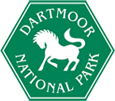Upland Oakwood
Upland oakwood is, as its name implies, woodland above 250m that is dominated by oak, although such woodland may include stands of alder and ash. Most of the woodland on Dartmoor is upland oakwood.
The UK's upland oakwoods are recognised as being internationally important because of their extent and distinctive plant and animal communities. Dartmoor has one of the main concentrations of these woods in the UK, with some very fine examples. Wistman's Wood and Black Tor Copse, two high altitude oakwoods rich in mosses, liverworts and lichens, are among the best known of these. Some of Dartmoor's oak woods are carpeted by bluebells in the spring: such bluebell woods are a unique British feature.
Ancient places
Most upland oakwoods within Dartmoor are ancient (i.e. thought to have been in existence before 1600). There are about 2,000 ha of ancient semi-natural woods over 2 ha in size within Dartmoor, 1,600 ha of this are oak woodland and a further 2000 ha upland oakwood is of recent origin.
The medieval Whiddon Deer Park, near Castle Drogo, with its fine ancient oak, ash and beech trees, is one of the best parks for lichens in the country. This is another habitat that is rare on the continent.
What trees and plants are found here?
The main tree species found in the oakwoods are, of course, oaks: both the English oak and the sessile oak occur, together with their hybrids. Other common trees are birches, with rowan, hazel and holly in the understorey. Many woods have wild service trees and a few small-leaved lime. Beech is another frequent tree, but it is not thought to be native to Dartmoor, except perhaps at Dendles Wood.
The ground flora is characterised by mosses, great woodrush, ferns, bilberry, or on drier slopes, by bracken and bramble. Where the soil is richer, plants like bluebell, wild daffodil, dog's mercury or ramsons may form extensive splashes of colour in the spring. Dunsford Wood and elsewhere in the Teign Valley, have exceptional and spectacular displays of wild daffodil.
The trunks and limbs of trees are often covered with rich gardens of mosses, polypody ferns and lichens, of which the leafy Parmelia and beard-like Usnea species are the most conspicuous lichens. The large and leafy tree lungwort Lobaria pulmonaria is found in quite a few ancient woods. The string-of-sausages lichen, a beard lichen which only grows in very clean air, is perhaps the most striking epiphyte, dripping down from on high in great festoons.
What wildlife can be found here?
A feature of many of Dartmoor's oakwoods is the presence of the nests of the wood ant. Other characteristic insects include four butterflies, the speckled wood, purple hairstreak, silver-washed fritillary and white admiral, the last being a recent coloniser on the eastern fringes of the National Park.
The bird community of these woodlands is also characteristic, with breeding pied flycatcher, wood warbler and redstart. Other frequent birds are raven, tree pipit and lesser-spotted woodpecker and buzzard. Buzzards breed here and Dartmoor is home to one of the most dense populations in Europe.
Many rare and uncommon lichens are also to be found in Dartmoor's oakwoods, including Graphina pauciloculata, a species which may be endemic to the UK, now known only from eight sites on Dartmoor and six sites in Cornwall and Wales. Bryoria smithii may now be restricted in the UK to Wistmans Wood and Black Tor Copse on Dartmoor. The lichen flora of Whiddon Deer Park includes Ramonia nigra (known from only one other site in Britain), Schismatomma graphioides and Collema furfuraceum.
Rare invertebrates include the blue ground beetle. This large and colourful species is now known from nine woods in the UK, five of which are on the edge of Dartmoor.
The dormouse has become extinct over half its former range in Britain, and is now widespread in only a few southern counties, of which Devon is one. Within the Dartmoor National Park it is still fairly common, being found in many oakwoods as well as in networks of thick, bushy hedges, and in the scrub in valley systems, often in association with Rhôs pasture. This tiny rodent is specially protected under the Wildlife and Countryside Act, and listed in the Habitats and Species Directive.
Looking after this habitat
A large number of Dartmoor's oakwoods are protected. There are National Nature Reserves at Yarner Wood, Bovey Valley Woodlands, Dendles Wood, Wistman's Wood and Black Tor Copse.
The Devon Wildlife Trust manages three oakwoods as nature reserves (Dart Valley Wood, Dunsford Wood and Lady's Wood), and the National Trust owns several others, in particular in the Teign Valley and at Hembury and Shaugh Prior. The Woodland Trust has a number of woodlands, of which the largest is Shaptor Wood. The National Park Authority owns a further five woods, namely Holne Woods, Whiddon Scrubs and three in the Wray Valley, and manages or assists with the management of many others.
The SSSI woods at Yarner, Bovey Valley, Hembury, Sampford Spiney, Shaugh Prior, Teign Valley and Holne form a candidate Special Area of Conservation (SAC) under the Habitats Directive, under the name of the South Dartmoor Woods. In addition, Dendles Wood and Wistman’s Wood are now included as extensions to the Dartmoor SAC. Seventeen woods have been notified as SSSIs and together they occupy 2,590 ha.
Many of the woodlands were previously coppiced for charcoal and oak bark which was used for tanning. This practice has largely stopped leaving the woods dominated by relatively young coppice regrowth and a dearth of large veteran trees. In grazed woods the ground flora is comprised of mainly mosses and ferns, whilst ungrazed woods can have an abundance of bracken and bramble. Many woods have an abundance of non-native trees such as Sycamore. Good woodland management is essential and much work is being done.
